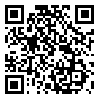Volume 13, Issue 2 (4-2023)
IJOCE 2023, 13(2): 189-205 |
Back to browse issues page
Download citation:
BibTeX | RIS | EndNote | Medlars | ProCite | Reference Manager | RefWorks
Send citation to:



BibTeX | RIS | EndNote | Medlars | ProCite | Reference Manager | RefWorks
Send citation to:
Payandeh-Sani M, Ahmadi-Nedushan B. OPTIMAL PLACEMENT OF MAGNETO-RHEOLOGICAL DAMPERS USING NSGA-II-BASED FUZZY CONTROL. IJOCE 2023; 13 (2) :189-205
URL: http://ijoce.iust.ac.ir/article-1-549-en.html
URL: http://ijoce.iust.ac.ir/article-1-549-en.html
1- Department of Civil Engineering, Yazd University, Yazd, Iran
Abstract: (20510 Views)
In this study, the response of semi-actively controlled structures is investigated, with a focus on the effects of magneto-rheological (MR) damper distribution on the seismic response of structures such as drift and acceleration. The proposed model is closed loop, and the structure's response is used to determine the optimal MR damper voltage. A Fuzzy logic controller (FLC) is employed to calculate the optimum voltage of MR dampers. Drifts and velocities of the structure’s stories are used as FLC inputs. The FLC parameters and the distribution of MR dampers across stories are determined using the NSGA-II, when the structure is subjected to the El-Centro earthquake, so as to minimize the peak inter-story drift ratio and peak acceleration simultaneously. The efficiency of the proposed approach is illustrated through a twenty-story nonlinear benchmark structure. Non-dominated solutions are obtained to minimize the inter-story drift and acceleration of structures and Pareto front produced. Then, the non-dominated solutions are used to control the seismic response of the benchmark structure, which was subjected to the Northridge, Kobe, and Hachinohe earthquake records. In the numerical example the maximum drift and acceleration decrease by about 36.3% and 15%, respectively, in the El-Centro earthquake. The results also demonstrate that the proposed controller is more efficient in reducing drift than reducing acceleration.
Keywords: Fuzzy logic controller, NSGA-II, multi-objective optimization, semi-active control, MR damper.
Type of Study: Research |
Subject:
Optimal design
Received: 2022/11/6 | Accepted: 2023/01/7 | Published: 2023/04/21
Received: 2022/11/6 | Accepted: 2023/01/7 | Published: 2023/04/21
Send email to the article author
| Rights and permissions | |
 | This work is licensed under a Creative Commons Attribution-NonCommercial 4.0 International License. |






